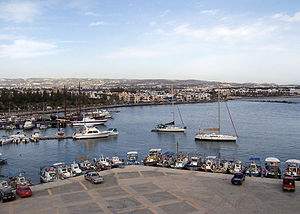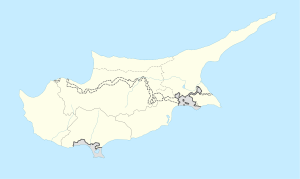Paphos
|
Paphos Πάφος (Greek) Baf (Turkish) |
||
|---|---|---|
 |
||
|
||
| Coordinates: 34°46′N 32°25′E / 34.767°N 32.417°E | ||
| Country |
|
|
| District | Paphos District | |
| Government | ||
| • Mayor | Fedonas Fedono | |
| Elevation | 72 m (236 ft) | |
| Population (2011) | ||
| • City | 32,892 | |
| • Urban | 61,986 | |
| Demonym(s) | Pafitis | |
| Time zone | EET (UTC+2) | |
| • Summer (DST) | EST (UTC+3) | |
| Post code | 8000–8999 | |
| Website | pafos |
|
| Pafos | |
|---|---|
| Name as inscribed on the World Heritage List | |
| Location | Cyprus |
| Type | Cultural |
| Criteria | iii, vi |
| Reference | 79 |
| UNESCO region | Europe |
| Inscription history | |
| Inscription | 1980 (4th Session) |
Paphos /ˈpæfɒs/ (Greek: Πάφος [ˈpafos]; Turkish: Baf) is a coastal city in the southwest of Cyprus and the capital of Paphos District. In antiquity, two locations were called Paphos: Old Paphos and New Paphos. The currently inhabited city, New Paphos, lies on the Mediterranean coast, about 50 km (31.07 mi) west of Limassol (the biggest port on the island), which has an A6 highway connection. Paphos International Airport is the country's second-largest airport.
Near Palaepaphos (Old Paphos) at the seaside of Petra tou Romiou is the modern mythical birthplace of Aphrodite, the Greek goddess of love and beauty, and the founding myth is interwoven with the goddess at every level, so that Old Paphos became the most famous and important place for worshipping Aphrodite in the ancient world. In Greco-Roman times, Paphos was the island's capital, and it is well known for the remains of the Roman governor's palace, where extensive, fine mosaics are a major tourist attraction. Paul the Apostle visited the town during the first century AD. The town of Paphos is included in the official UNESCO list of cultural and natural treasures of the world's heritage.
...
Wikipedia


